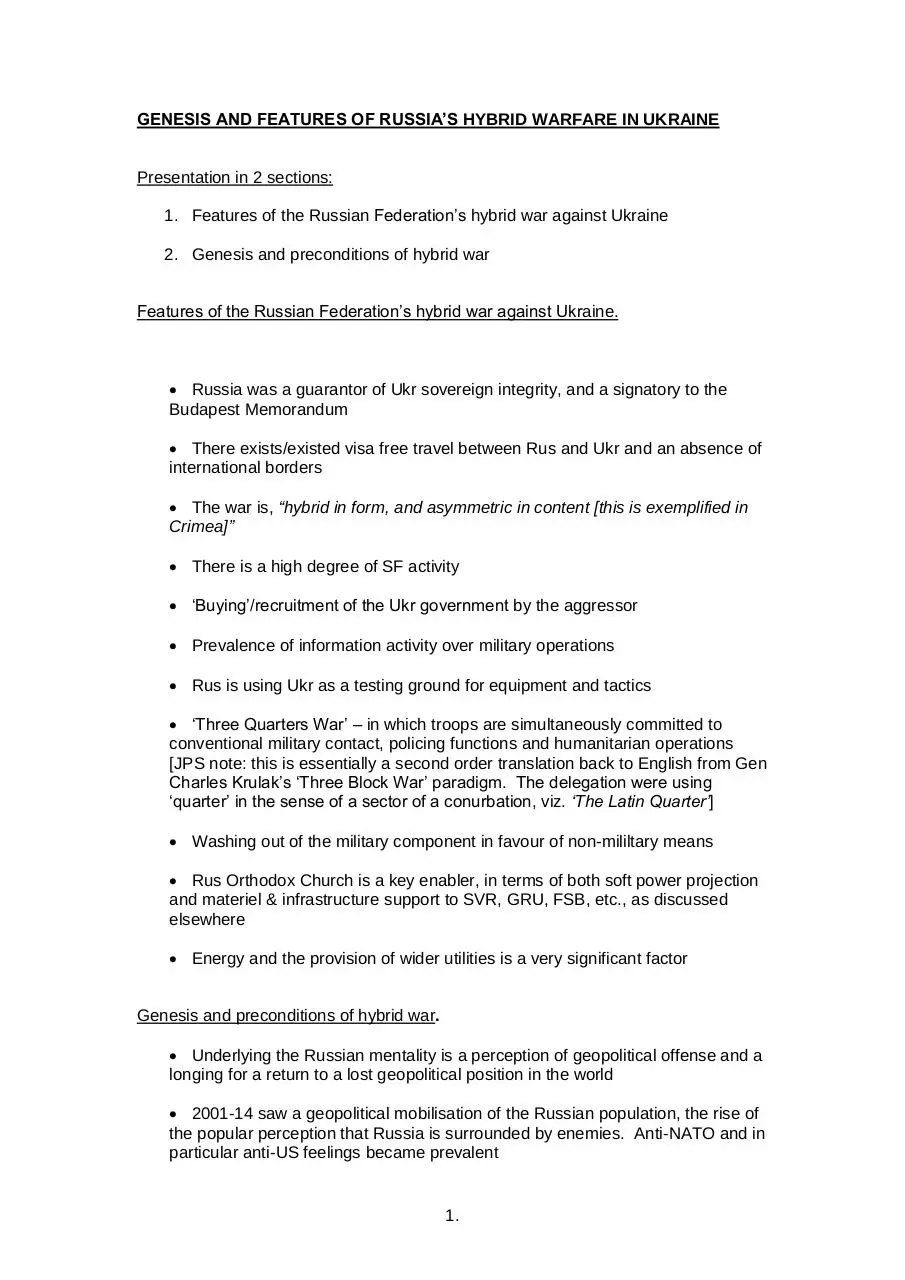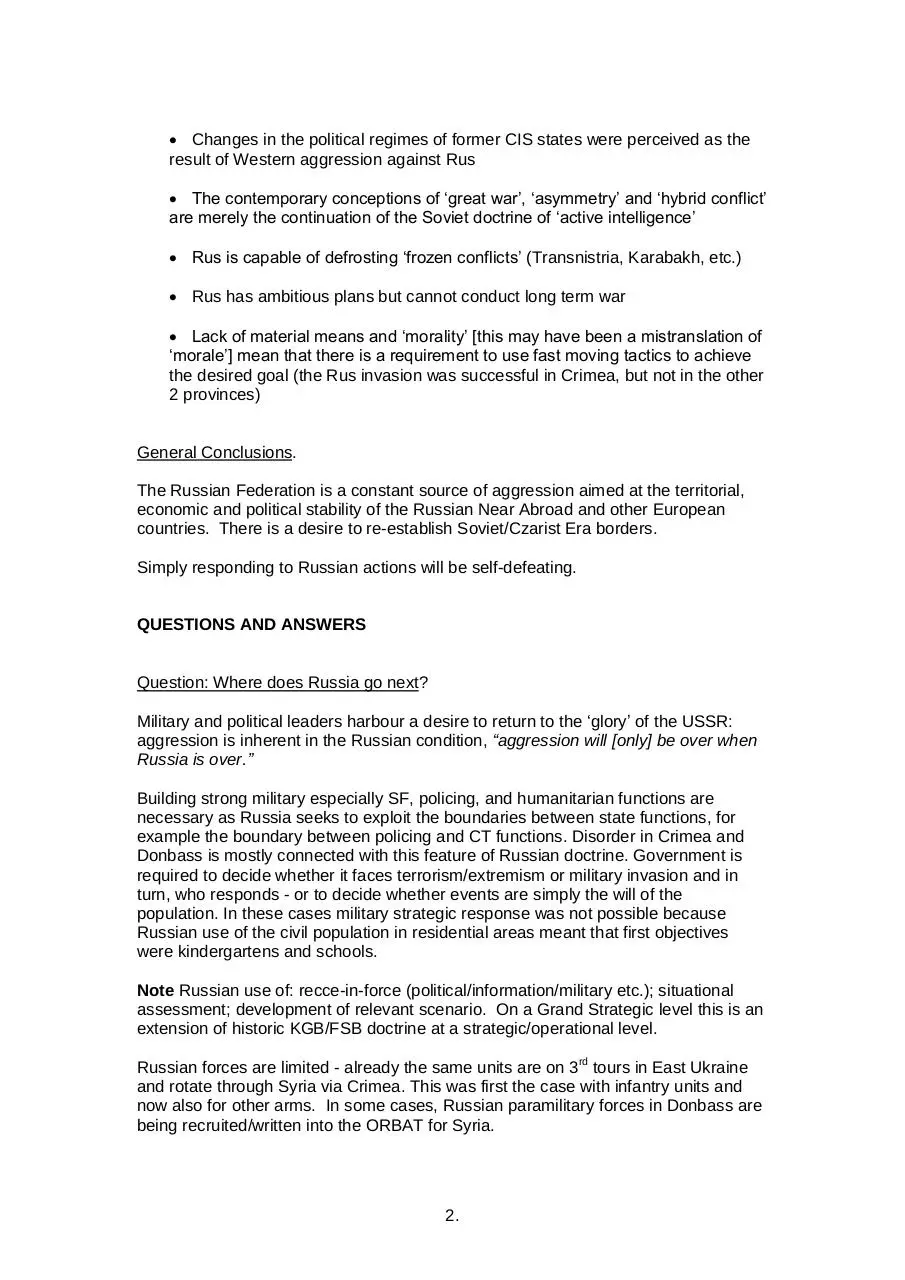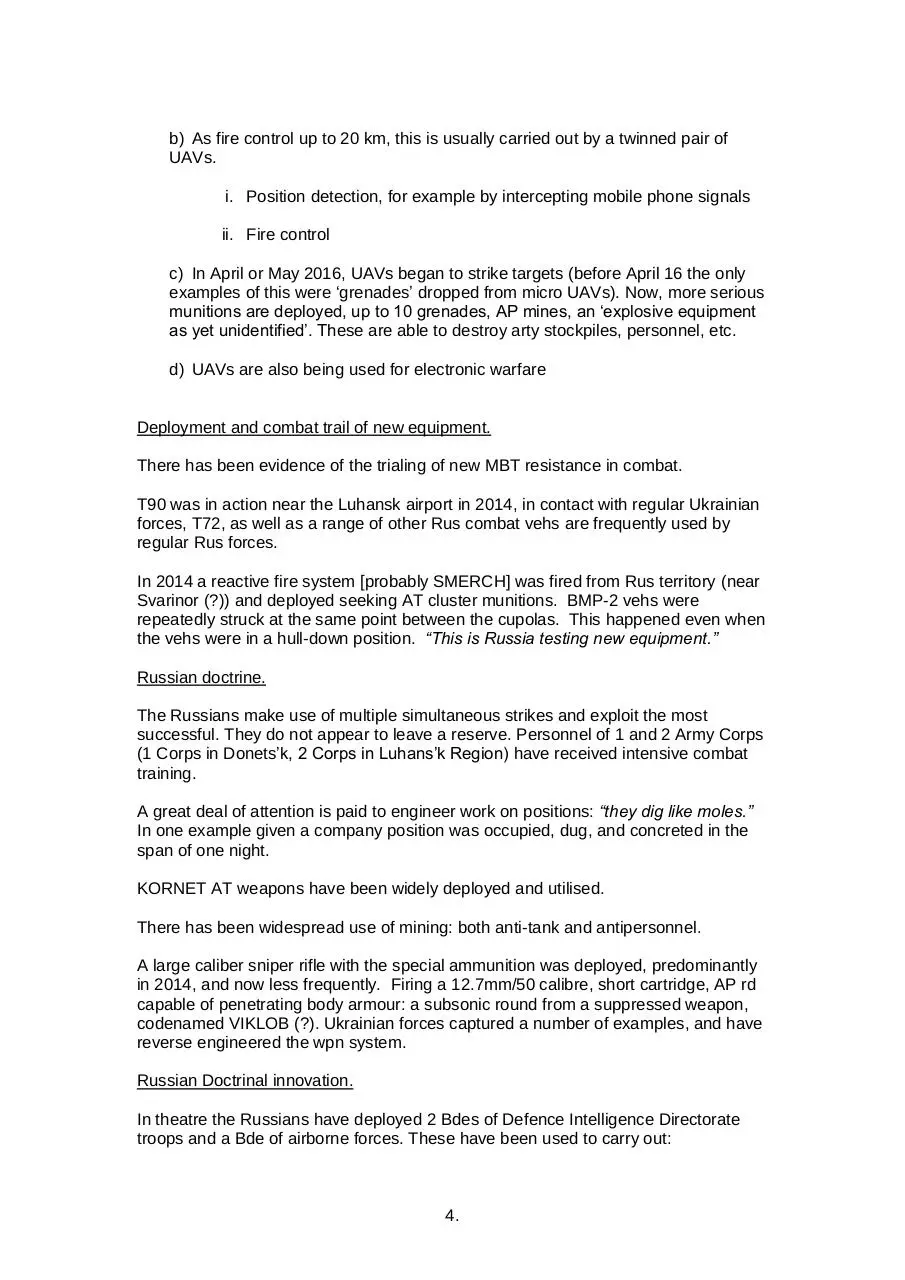Jon Searle Ukr Hybrid Warfare notes (PDF)
File information
This PDF 1.5 document has been generated by , and has been sent on pdf-archive.com on 24/01/2019 at 09:52, from IP address 2.139.x.x.
The current document download page has been viewed 987 times.
File size: 318.18 KB (6 pages).
Privacy: public file





File preview
GENESIS AND FEATURES OF RUSSIA’S HYBRID WARFARE IN UKRAINE
Presentation in 2 sections:
1. Features of the Russian Federation‟s hybrid war against Ukraine
2. Genesis and preconditions of hybrid war
Features of the Russian Federation‟s hybrid war against Ukraine.
Russia was a guarantor of Ukr sovereign integrity, and a signatory to the
Budapest Memorandum
There exists/existed visa free travel between Rus and Ukr and an absence of
international borders
The war is, “hybrid in form, and asymmetric in content [this is exemplified in
Crimea]”
There is a high degree of SF activity
„Buying‟/recruitment of the Ukr government by the aggressor
Prevalence of information activity over military operations
Rus is using Ukr as a testing ground for equipment and tactics
„Three Quarters War‟ – in which troops are simultaneously committed to
conventional military contact, policing functions and humanitarian operations
[JPS note: this is essentially a second order translation back to English from Gen
Charles Krulak‟s „Three Block War‟ paradigm. The delegation were using
„quarter‟ in the sense of a sector of a conurbation, viz. „The Latin Quarter‟]
Washing out of the military component in favour of non-mililtary means
Rus Orthodox Church is a key enabler, in terms of both soft power projection
and materiel & infrastructure support to SVR, GRU, FSB, etc., as discussed
elsewhere
Energy and the provision of wider utilities is a very significant factor
Genesis and preconditions of hybrid war.
Underlying the Russian mentality is a perception of geopolitical offense and a
longing for a return to a lost geopolitical position in the world
2001-14 saw a geopolitical mobilisation of the Russian population, the rise of
the popular perception that Russia is surrounded by enemies. Anti-NATO and in
particular anti-US feelings became prevalent
1.
Changes in the political regimes of former CIS states were perceived as the
result of Western aggression against Rus
The contemporary conceptions of „great war‟, „asymmetry‟ and „hybrid conflict‟
are merely the continuation of the Soviet doctrine of „active intelligence‟
Rus is capable of defrosting „frozen conflicts‟ (Transnistria, Karabakh, etc.)
Rus has ambitious plans but cannot conduct long term war
Lack of material means and „morality‟ [this may have been a mistranslation of
„morale‟] mean that there is a requirement to use fast moving tactics to achieve
the desired goal (the Rus invasion was successful in Crimea, but not in the other
2 provinces)
General Conclusions.
The Russian Federation is a constant source of aggression aimed at the territorial,
economic and political stability of the Russian Near Abroad and other European
countries. There is a desire to re-establish Soviet/Czarist Era borders.
Simply responding to Russian actions will be self-defeating.
QUESTIONS AND ANSWERS
Question: Where does Russia go next?
Military and political leaders harbour a desire to return to the „glory‟ of the USSR:
aggression is inherent in the Russian condition, “aggression will [only] be over when
Russia is over.”
Building strong military especially SF, policing, and humanitarian functions are
necessary as Russia seeks to exploit the boundaries between state functions, for
example the boundary between policing and CT functions. Disorder in Crimea and
Donbass is mostly connected with this feature of Russian doctrine. Government is
required to decide whether it faces terrorism/extremism or military invasion and in
turn, who responds - or to decide whether events are simply the will of the
population. In these cases military strategic response was not possible because
Russian use of the civil population in residential areas meant that first objectives
were kindergartens and schools.
Note Russian use of: recce-in-force (political/information/military etc.); situational
assessment; development of relevant scenario. On a Grand Strategic level this is an
extension of historic KGB/FSB doctrine at a strategic/operational level.
Russian forces are limited - already the same units are on 3rd tours in East Ukraine
and rotate through Syria via Crimea. This was first the case with infantry units and
now also for other arms. In some cases, Russian paramilitary forces in Donbass are
being recruited/written into the ORBAT for Syria.
2.
Ukraine should fear „frozen conflict‟ because this brings the danger of terrorism, but
also political and economic factors. In the Ukraine more than 300 terror acts have
been stopped this year.
If in 2-3 years, on a tactical level there is still hard resistance from Ukraine, there will
be continued political and economic attacks from Russia. This will probably also be
the case in other countries.
Question: What does the delegation perceive as Russian tactical weaknesses?
Events in Crimea are only one side of the coin. Rus deployed modern equipment in
terms of arms, new vehicles, equipment, but the other side of the coin was unseen:
hungry, uncared-for soldiers, asking for help from Ukrainian forces. In Donbass some
units were very professional during operations, however some regular Russian units
were observed sleeping rough. There are some highly professional combined Arms
artillery units, but also some very unprofessional behavior by the units.
Russian tactics seem to copy those of the Wehrmacht: artillery attack; closing; frontal
attack. In failure, they ask for a truce to retrieve bodies. In Donetsk in 2015, there
was infiltration of attack groups through Ukr lines and the deployment simultaneously
of a second echelon to support the success of the first line. The second echelon,
which consisted of regular Russian forces, were destroyed with artillery.
A standard three-line/echelon doctrine is applied in both attack and defence:
a) Mercenaries/pro-Russian separatists/criminal elements
b) Regular Russian forces
c) Beria units of the Russian national guard to prevent the retreat of the first and
second echelons
When not successful, for example as at Donetsk Airport, SF of FSB were committed
to the fight. In some cases commanders refused to commit because the risk of
failure, for example the marines at Donetsk airport. The commander was
subsequently dismissed.
UKRAINE AS A TESTING GROUND.
Question: do they learn the lessons of new technical innovation–and are these
lessons passed on to successor units?
Implementation of UAVs.
Russia has significantly widened the technical use of battlefield UAVs. In the early
phases they were used by chance without any system. There were a number of
deployments of commercial UAVs by paramilitary gps, but true combat UAVs were
Russian. Today Russia have 2 specialized UAV companies carrying out operations
as:
a) Recce in depth up to 50 km – these are autonomous and carry on even when
GPS has been suppressed. The manufacturer visits the Coys frequently and
implements improvements.
3.
b) As fire control up to 20 km, this is usually carried out by a twinned pair of
UAVs.
i. Position detection, for example by intercepting mobile phone signals
ii. Fire control
c) In April or May 2016, UAVs began to strike targets (before April 16 the only
examples of this were „grenades‟ dropped from micro UAVs). Now, more serious
munitions are deployed, up to 10 grenades, AP mines, an „explosive equipment
as yet unidentified‟. These are able to destroy arty stockpiles, personnel, etc.
d) UAVs are also being used for electronic warfare
Deployment and combat trail of new equipment.
There has been evidence of the trialing of new MBT resistance in combat.
T90 was in action near the Luhansk airport in 2014, in contact with regular Ukrainian
forces, T72, as well as a range of other Rus combat vehs are frequently used by
regular Rus forces.
In 2014 a reactive fire system [probably SMERCH] was fired from Rus territory (near
Svarinor (?)) and deployed seeking AT cluster munitions. BMP-2 vehs were
repeatedly struck at the same point between the cupolas. This happened even when
the vehs were in a hull-down position. “This is Russia testing new equipment.”
Russian doctrine.
The Russians make use of multiple simultaneous strikes and exploit the most
successful. They do not appear to leave a reserve. Personnel of 1 and 2 Army Corps
(1 Corps in Donets‟k, 2 Corps in Luhans‟k Region) have received intensive combat
training.
A great deal of attention is paid to engineer work on positions: “they dig like moles.”
In one example given a company position was occupied, dug, and concreted in the
span of one night.
KORNET AT weapons have been widely deployed and utilised.
There has been widespread use of mining: both anti-tank and antipersonnel.
A large caliber sniper rifle with the special ammunition was deployed, predominantly
in 2014, and now less frequently. Firing a 12.7mm/50 calibre, short cartridge, AP rd
capable of penetrating body armour: a subsonic round from a suppressed weapon,
codenamed VIKLOB (?). Ukrainian forces captured a number of examples, and have
reverse engineered the wpn system.
Russian Doctrinal innovation.
In theatre the Russians have deployed 2 Bdes of Defence Intelligence Directorate
troops and a Bde of airborne forces. These have been used to carry out:
4.
a) Sabotage in the close rear
b) Attacks on Air Defence positions and stocks
c) Rear infrastructure objectives
d) Attacks on frontline objectives
These are all supported by artillery fire is on a massive scale. Russian tactics echo
those of the Wehrmacht:
a) Fires strike on the perimeter of objective
b) Airborne and special forces jump in
c) Extraction is achieved under heavy covering artillery fire
These operations are usually accompanied by UAV.
Question: What is the delegation‟s assessment of Russian logistical capabilities?
In 2014 G4 was chaotic and exhibited a lack of formal organisation. After the
occupation of Donets‟k, uniform, arms, ammunition were brought in in huge
quantities but then stored and not distributed.
More recently supplies have been centralized and are distributed with the use of
“humanitarian convoys”.
The significant quantities of Arty ammunition which have been used suggested
logistic support is not the most important factor in slowing down future Russian
expansion. This is more like to be psychological: the rotation period of units in the
front line (again, as per Wehrmacht doctrine) is 21 days.
Ukraine developed plans to cut “logistic routes” as “a tank without fuel is no use”. It
was assessed at 11 x 9 strong gps, with HUMINT prep, would require 11–13 days to
destroy the Russian logistic system.
Question: How was the Russian Federation responding to significant casualties?
The huge size of the Russian homeland means that Bns raised from across the
country return a casualtiy footprint which is distributed throughout a continent. In
addition the Russian population is subject to a powerful propaganda machine which
downplays combat losses.
Question: historically Soviet/Russian deployments have been heavily doctrine lead how does this fit with the „trials environment‟?
The first phase of the conflict saw lots of paramilitary structures which have now all
been reorganized into regular detachments within the 2 Rus Army Corps. Those
paramilitary units which did not wish to be assimilated were forced to do so–
sometimes on pain of death.
There is a strict command and control system.
5.
Question: at what command level does initiative vest?
Limited initiative lies the Commander at Military District Level. He is able to make
some technical decisions within the boundaries of the doctrine. At lower levels,
commanders simply enact orders. At Coy level and higher, units which were formerly
pro-Russian separatist paramilitary groups are all accompanied by a “military
advisor”, who is able to overrule PRS commanders. “The PRS are simply
marionettes [puppets].”
6.
Download Jon Searle Ukr Hybrid Warfare notes
Jon Searle Ukr Hybrid Warfare notes.pdf (PDF, 318.18 KB)
Download PDF
Share this file on social networks
Link to this page
Permanent link
Use the permanent link to the download page to share your document on Facebook, Twitter, LinkedIn, or directly with a contact by e-Mail, Messenger, Whatsapp, Line..
Short link
Use the short link to share your document on Twitter or by text message (SMS)
HTML Code
Copy the following HTML code to share your document on a Website or Blog
QR Code to this page

This file has been shared publicly by a user of PDF Archive.
Document ID: 0001906598.